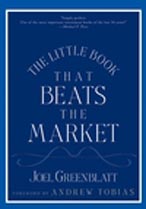The Little Book That Beats The Market
A review by Andrew Forward, of Joel Greenblatt's book on the Magic Formula for stock picking

- If you really want to beat the market, professionals and academics cannot help you
- That means you must do it yourself
This small tale will teach you
- How to view the stock market
- Why success eludes almost all people (including professionals)
- How to find good companies at bargain prices
- How you can beat the market by yourself
It is important to have a baseline, no-risk alternative whenever you are consider an investment. If this risky investment does not greatly exceed that baseline, then why bother? For the purpose of this book, we will consider a 6% return to be risk-free (now as of today's standards, this is quite high, but the actual number does not matter, but rather the fact that you know what the number is).
Stock prices move around wildly over the short term - this does not mean that the underlying companies have changed much. Think of the stock market as a crazy guy named Mr Market.
Buying shares in a company at large discounts is good - but you cannot tell bargains from busts. The rest of the examples will talk about Jason's Gum Shoppe.
Buy companies with high earnings yield
Let us say that Jason's Gum Shoppe made $1.2 million dollar profit last year, and the stock price is trading at $12, and the company has 1 million outstanding shares. That means the company is worth $12 million dollars and it was able to make $1.2 million in profit - or a 10% return (earnings yield). Now, what if that company made $2.4 million - or a 20% earnings yield? From here we see that the higher the earnings yield the better.
Buy companies with high return on capital
Let us say that Jason spent about $400k on each of his stores and each store made a profit of $200k. That means that Jason was able to recoup 50% of his investment (in one year). Now what if, Jimbo's Just Broccoli made a profit of 10k - that is only a 2.5% return (which is well below the risk-free alternative). So, having a higher return on capital is better.
Combine high earnings yield and high return on capital
Why not combine a discounted stock price (i.e. a company that has a high earnings yield) with a good company (i.e. a company that gets a high return on its capital) and make a lot of money.
Good news, the formula does not always work
For if it did, everyone would be using this magic formula, and the bargains would be gone. In the short term, which may be years, the forumla will suck! But, in the long term the formula will work great.
Risk is about two things
- What is the risk of losing money over the long term?
- What is the risk that your strategy will perform worse than alternative strategies in the long term?
Step-by-step instructions
Step 1
Go to magicformulainvesting.com.
Step 2
Choose company size (from 50 million to 1 billion in market capitalization).
Step 3
Follow the instructions to get a list of top-ranked magic formula companies.
Step 4
Buy 5 to 7 top ranked companies. To start only invest 20%-33% of your total money you wish to invest during the first year.
Step 5
Repeat Step 4 every two to three months until you have invested all of your money (in which case you shold have 20 - 30 stocks).
Step 6
Hold the stock for 1 year. If the stock is at a loss, sell it a few days before 1 year, and if it is at a gain then sell it a few days after the 1 year mark (if outside a tax shelter). Use the proceeds and any additional money to replace the sold companies with new magic formula companies.
Step 7
You must continue this process for at least 3 years - regardless of the results.